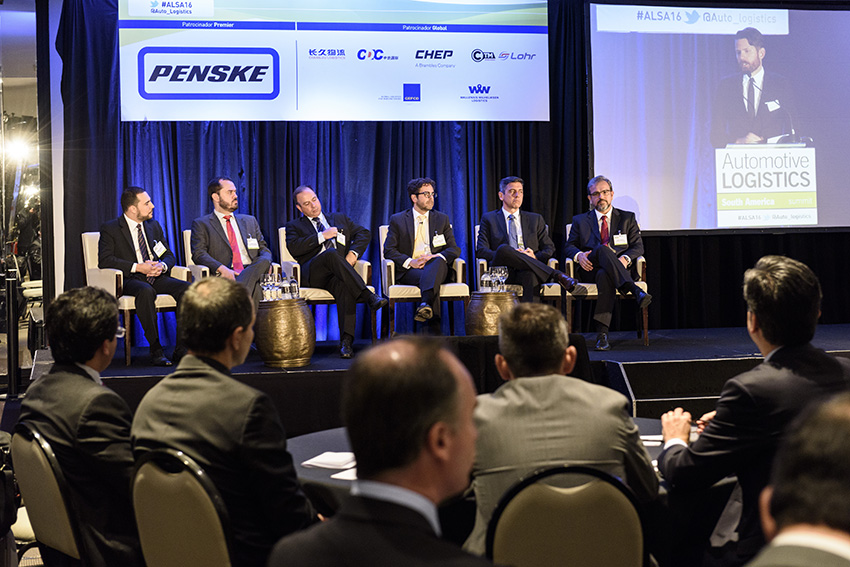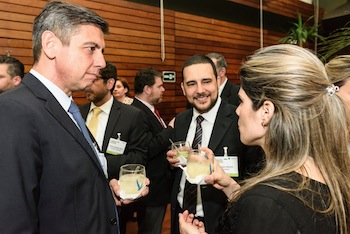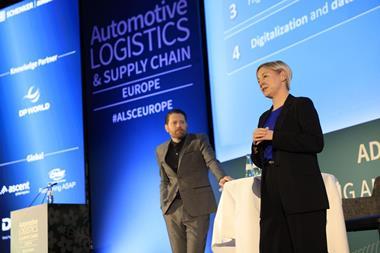The South American automotive landscape is looking bleak as sales and production continue to drag and excess capacity increases. But a crisis is also a turning point, as speakers at this year’s Automotive Logistics South America summit in São Paulo pointed out...
However, while Brazil has fallen from being the fourth biggest automotive production base worldwide to the eleventh, a number of speakers at this week’s summit suggested now was the time to instil new thinking in the supply chain and build in greater efficiencies to make the most of the recovery over the next 5-10 years. The South American market may be suffering now but that makes it an opportune time to bring in major change to the way business is done and make the most of future profitability.
“We are always in crisis; it is just the nature of the crisis that changes,” said Edson Molina, until recently director of logistics in South America for Ford, and now an independent consultant. Brazil, Argentina and Venezuela were all in trouble, he noted, but there were basically just two courses of action available: “You can either sit down and cry, or roll up your sleeves,” he said.
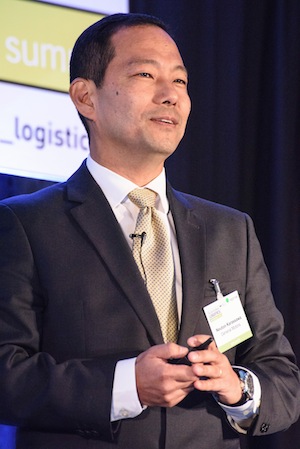
[sta_anchor id="1"]GM’s Neuton Karassawa, logistics director for South America, put the opportunities available in a crisis more colourfully: “Every time someone cries, someone else is selling handkerchieves,” he said, adding that the automotive industry had to reinvent itself now to return to growth.
Figuring out BrazilIt is no wonder there are tears being shed, given the bleak production and sales figures in South America. This year is set to be the worst in the last decade in terms of sales and production, in fact.
Brazilian domestic sales are set to just about reach half the level of 2012, when they hit 3.8m, and while Argentina is showing preliminary signs of recovery, it is expected to be slow and closely tied to Brazil’s ability to purchase the country’s goods.
South America’s regional contribution to global automotive growth is at 4.1%, compared to the emerging Asia Pacific region’s 65.4%, according to figures from analyst firm PwC. Production volume is only expected to grow 0.9% between last year’s 3.1m figure and the 4m predicted for 2022.
Brazil accounts for 75% of South America’s automotive output but, like sales, installed production capacity has almost halved, falling to 47% this year from 86% in 2010; when installed capacity falls below the breakeven point of 70%, companies begin to suffer and it is not likely to return even to that level in the foreseeable future. PwC sees a gradual build in the plant utilisation rate to just 62% by 2022. This year there are 3.1m units of excess capacity.
In short, Brazil has been put back a decade and its boom-time output forecast of 5m by 2020 now just looks like a pipe dream. Mexico has usurped its position and is on target to make just over 5m units by 2020, a 50% growth rate based on its output last year. Meanwhile, according to PwC’s director in Brazil, Marcelo Cioffi, it is currently impossible to make any accurate predictions about the industry in Brazil beyond 2022. At that point, the country will be 1m short of its original forecast at best.
[sta_anchor id="2"]What is more, the country is still plagued by underdeveloped infrastructure, both inland and at its ports. Brazil languishes in 83rd place in the Global Logistics Index.
So what is to be done?
Exports to the rescueExport trade offers one avenue of potential. Brazil has excess installed capacity following the investments of the six years ago, meaning it is well-positioned to grow. Cioffi said the call now was to look at bilateral contracts and exports.
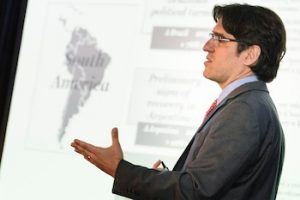 PwC’s Marcelo Cioffi: Impossible to make accurate predictions about the industry in Brazil beyond 2022
PwC’s Marcelo Cioffi: Impossible to make accurate predictions about the industry in Brazil beyond 2022“Unfortunately we have a lost decade when we look at the levels of 2013,” said Cioffi. “The situation is now really complicated and the government has to think about this – and exports may be a way out of the problem.”
That point was picked up by Ana Paula Quaresma, head of commercial for Latin America at global integrated logistics and ocean services provider, Wallenius Wilhelmsen Logistics.
“We know where the exports are and where the growth is, and that is where we need to be,” she said. “Our focus is on helping exports. We have an imbalance but we can address this.”
Quaresma pointed to examples where growth could come from for WWL, including the distressed high and heavy market in South America. She said Chile was showing positive signs in terms of vehicle purchasing and that construction, mining and agricultural developments were underway in Bolivia and Peru which could see used machines being moved there from Brazil.
One of the things the government has done to help export trade this year is introduce the second phase of the Brazilian Authorised Safe Operator Programme (OEA), which replaces the previous express customs clearance regime, known as Blue Line (Linha Azul). The OEA is designed to ease the customs clearance process and as part of the new customs regime the government has also expanded access to the Special Customs Industrial Bonded Warehouse Regime (Recof), which allows companies to export tax-free.
The move was welcomed by carmakers at this year’s conference. “We know the difficulties the country has now but the government has done an excellent job, bringing this in,” said Gustavo Bonini, senior manager for supply chain at Renault. “There are difficulties at the moment but if we think down the line the strategy is good and aims at establishing a standard for companies to become more agile. It won’t take us long to benefit from this. When we start using our idle space to export, we won’t have barriers hindering exports,” he said.
Edson Molina pointed out that the new regime was an improvement on the previous system.
[sta_anchor id="3"]“Blue Line was complex,” he said. “There has been a process management improvement and better fiscal governance. It will make things easier and more consistent. The Argentinians had something similar but they went back on the process. We should continue with it and the ongoing improvement to the revenue system.”
 Ana Paula Quaresma of WWL: Export growth could come from various sources including the distressed high and heavy market in South America
Ana Paula Quaresma of WWL: Export growth could come from various sources including the distressed high and heavy market in South AmericaSupplier relationships crucialSomething else that is bringing benefits to carmakers is the closer relationship their logistics departments are enjoying with tier suppliers setting up more localised manufacturing facilities. This is lowering logistics costs and providing more flexibility during the crisis.
Luis Santamaria, vice-president of supply chain Latin America at Fiat Chrysler Automobiles (FCA), pointed to the carmaker’s plant in Pernambuco state as a good example, with its main suppliers located its supplier park.
“The main suppliers are inside our supplier park to minimise the logistics cost and have more flexibility,” said Santamaria. Up to 70% of parts and equipment for the site are sourced in Brazil.
The $2.4 billion Pernambuco plant, one of two FCA has in Brazil, will make three models on three different platforms, including the Jeep Renegade, which was developed in Europe, and the Jeep Compass. Building on three different platforms in the same plant was made possible in large part because of FCA’s strategic planning with its most critical suppliers, as well as a long-term view on localisation to give the plant more flexibility and lower the logistics cost, explained Santamaria.
“We work with the suppliers, including on integrated planning, which makes things a lot easier and minimises risk,” he said, adding that the synergies set up in the park minimise the impact of supply problems. “It is a great leverage to have global suppliers, not only for the parts themselves, but for the logistics. This is done at the local and global level.”
Jaguar Land Rover has also benefitted from a closer strategic relationship with its suppliers in terms of logistics. Marcelo Navarro, senior manager, MP&L at JLR, said his department was closely involved in localisation of supply. Logistics even influenced the company’s decision to build the 750m reais ($215m) plant in Itatiaia, in the state of Rio de Janeiro, which opened in June this year.
“The logistics department took part in choosing the location of the plant and when we did the sequencing, all the suppliers had to come close to the plant,” said Navarro. “That was the time when we took the opportunity to develop the efficiency of the logistics with the supplier, not just to choose where the plant would be but to help with the flows. We had the opportunity of starting from scratch and at this point, logistics came into the development of supply routes. Everything was developed from scratch with the suppliers. Logistics had a crucial role [to play] to give us the highest efficiency.”
The economic crisis that hit Brazil came after JLR had begun construction of the plant. Rather than abandon the facility in the face of collapsing sales, however, JLR took the opportunity to plan more carefully. The plant now makes the Land Rover Discovery Sport and Range Rover Evoque.
Navarro said that being a low volume plant at the moment had its challenges – and a big one was where to find the opportunities while there were reduced flows.
“Everybody here has been saying that low volume production brings us the opportunity to improve,” said Navarro. “We have to reduce costs and be more efficient and now is the time to think about that. Later on, when we have higher volumes, we won’t be able to do it. What we have been doing in Brazil now will bear fruit in the future. We don’t expect recovery in the short term but when it comes, we will be well prepared.”
That was also true at FCA’s Pernambuco plant, which has capacity to make 4m-5m units annually but is currently making just 2m. Santamaria confirmed that the downturn had enabled it to build in greater efficiency.
[sta_anchor id="4"]“The plant is 30-40% more efficient, thanks to the crisis,” he said. “The crisis led to a rethink of what was possible in the new plant.” He added that the Pernambuco plant was a world-class manufacturing facility and that had come about because the demands of the crisis had led to a collaborative emphasis on leaner processes, which it could now apply to its other, more mature plants around the world.
Problems in purchasingWhere collaboration is still missing, however, is in the way logistics services are bought, according to Paulo Sarti, president of Penske Brazil, a major non-asset owning logistics provider to the automotive industry there. He said the way logistics services were bought had to change because the lack of flexibility was having a big impact on the sector at a time of crisis. One of the main problems was being tied to the traditional bidding process, which wasted time and did not necessarily target the company with the most appropriate skills for the job.
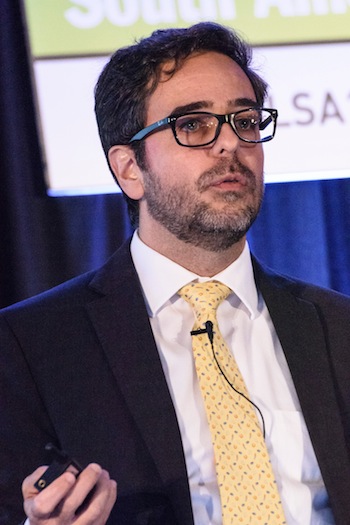 Paulo Sarti of Penske Brazil: Traditional bidding process wastes time and doesn't necessarily target the company with the most appropriate skills for the job
Paulo Sarti of Penske Brazil: Traditional bidding process wastes time and doesn't necessarily target the company with the most appropriate skills for the job“You can’t bring in a specific supplier to solve a problem; you have to go through the bidding process, which takes time,” said Sarti. “While you define the service needed internally, you then have to open the bidding process and that may attract 30 participants, some of which may not have a clue how to solve the issue you have.”
That process is followed by one looking at how the service is costed out, which switches the focus to how much the service provider will earn, rather than how much you can reduce the cost by, he added.
“Too much of this happening,” said Sarti. “It leaves no space for innovation. How can you have something new if it is already formatted? New ideas are thrown on the market and everyone bids the same way, but we all have responsibility to change the existing model.”
[sta_anchor id="5"]Sarti said companies looking for services that their existing providers could not supply needed to limit the number of providers they were choosing from.
Talented people a priorityWhat was also important for FCA – and was later reiterated by a number of companies at this year’s summit – was the development of a good labour force, said Santamaria. However, there are ongoing challenges in Brazil in recruiting the next generation to the automotive logistics sector. A directive on training is needed and the carmakers are also using the time available because of less productivity to do some in-house training at their plants.
“There is a great challenge in creating a labour force in an area that has no history of it,” said Santamaria. “It is a time for education and we have been doing this successfully at Pernambuco.”
Renault’s Gustavo Bonini agreed that now was the time to develop the skills of the workforce and that when volumes were low, companies could be more creative.
Santamaria said that while its two plants were “different worlds” – the Betin plant is 30 years older than Pernambuco – what was common between the two was the training of its staff and that was important for the future of its business.
“Without the right people, we won’t be able to sustain our business,” he said. “Training people is the big challenge for this industry and its leaders will have to start thinking of this today. We may not even know now exactly what the skills are that we will need, but we do need to think about this and how we will organise ourselves. We have been closed to this in Brazil and lost opportunities for communication. What we need to do now is educate for the next generation.”
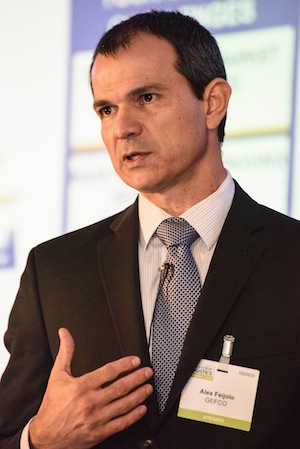 Gefco Brazil's Alex Feijolo: There are well trained people in Brazil and the logistics sector needs to find more ways to attract them, including in-house training
Gefco Brazil's Alex Feijolo: There are well trained people in Brazil and the logistics sector needs to find more ways to attract them, including in-house trainingAt Gefco Brazil, Alex Feijolo, director of sales and marketing, said his company was looking to do just that. “We have grown our team quite a lot in Brazil. There is a greater availability of well trained people in Brazil now and we need to attract them into our sector and do training ourselves in-house,” he confirmed.
That was certainly something Fabio Garcia, supervisor, logistics parts and accessories, MAN Latin America, agreed with, confessing that, while others may have football as a hobby, his was teaching. Garcia said the industry had lost a lot of talent but now had the chance to regain it, given the unemployment the economic crisis had caused. Getting that talent back was paramount, he suggested.
“In the future, we will have problems without the competencies we need,” he warned. “The good news is that we can recover it, and we have the means to develop the workforce and train the next generation.”
That will require proactive collaboration from the industry, however, including logistics providers, and schools, so logistics professionals were better prepared, he continued. Garcia stressed there needed to be more spending in education and companies needed to educate and train their workforces better. People could also learn from working in different logistics areas within their own companies and by moving to different regions.
“People are leaving the industry that are experts and companies lose a lot when they lose their seasoned professionals,” he commented. “The next generation does not have the same view that it is great to work with the automotive industry. We need to encourage them [to see] that it is, while also keeping the professionals we are losing.”
Paulo Sarti agreed that recruiting talent was a huge concern for Penske Brazil and involved both attracting people to the job and retaining the talent already there.
“Young people don’t find logistics a charming industry to work in but if you become a logistics expert you have options to work in different industries,” he noted. “Your career can develop along dynamic lines as you move into different segments.”
Sarti said his company had established a programme to promote and progress staff up to and through the senior ranks of logistics expertise but that also allowed people to move around within the company to other operations and segments, both vertical and horizontal.
Companies also needed to motivate their people, suggested Navarro. “Volumes are low and people are pessimistic but we cannot let this happen,” he said. “We have to look at the future and we have to be motivated. We have to retain talent and develop an enthusiastic workforce. Regardless of volume, my team is very motivated. The more we motivate them, the more we will gain.”
What was also important for the industry as it took the chance to reorganise itself for the future was that leaders listened to the people involved right the way along the supply chain, said Edson Molina.
[sta_anchor id="6"]“Logistics is extremely complex along the supply chain and you will be surprised what you learn when you actually listen to people,” he pointed out. “[You need to] teach and learn at the same time and adjust to the local mode of doing things.”
 Rui Cunha of Walmart Brazil: Bad planning had led to an over-emphasis on opening stores, rather than supporting the supply chain
Rui Cunha of Walmart Brazil: Bad planning had led to an over-emphasis on opening stores, rather than supporting the supply chainThe detail in retailLessons can also be learned by looking at other industries, of course, and at this year’s summit, Rui Cunha, general director of supply chain at Walmart Brazil, introduced automotive delegates to some of the challenges currently facing the retail sector.
The retail sector in Brazil has experienced its own problems since the economic downturn, he said, with a drop of almost 7% in terms of revenue. Walmart has also experienced its own problems in the supply chain, which Cunha blamed on bad distribution planning (or having no plan at all) during a period of fast growth.
“Our capital was dedicated to opening stores, not supporting the supply chain,” he explained, going on to outline how wool garments made in Brazil travelled 90,000km around the world during the various stages of product development but often got lost during the last 50 metres because of warehouse mismanagement. “We are trying to fix bad planning,” he said. “We have a network redesign process this year to avoid these mistakes.”
Cunha also said that product flow patterns had to change at Walmart because staple food products, such as rice and salt, were sometimes missing from its shelves in Brazil. Under his leadership, the company changed its performance measurements on goods flows, he said.
“Everything now starts with a channel decision,” said Cunha. “[You have to decide:] should it go to a distribution centre or straight to the store? We have developed algorithms which control this and salt and rice are never absent because they need a good stock. We started to demand inflow from our suppliers.”
When it came to the talent of the people employed, there was no magic formula, according to Cunha. He agreed with the OEM representatives at the conference that it was difficult to attract and retain good professionals in the logistics industry.
[sta_anchor id="7"]“In supply chain, it has to be like a band. Everyone does their part,” he said – pointing out that Walmart actually had a band that played at its annual supply chain gathering of more than 400 professionals, an open event designed to foster integration.
More realistic approach to the futureAnother advantage of the tough lessons learned during these years of downturn is that there is a more realistic approach among companies operating in the South America region.
“The advantage is that we know what is going on and we have reduced our expectations,” said Alex Feijolo at Gefco Brazil. “No-one is making investments expecting a big return. The car industry is focused on new model development and looking at maintaining market share.”
The low productivity level and volumes in South America at the moment mean automotive companies have some breathing space to improve processes, which can be difficult to do during times of maximum output, added Navarro of JLR.
GM’s Karassawa made the same point, suggesting that this was the time to do something different, rather than just complain and continue to drift in stagnant waters. He pointed to the word ‘crisis’ as written in Mandarin, which is made of two ideograms – one meaning ‘danger’ and the other meaning ‘opportunity’.
“This is the time to bring new ideas to the challenges we face,” he said. “The organisations themselves are open to new ideas at times of crisis. We do things that in normal situations we would never think of. Now we have to be agents of change.”
For Karassawa, that came down to inspiring leadership that brought a sense of purpose to the job at hand. “Work with that in mind and it will permeate all parts of the organisation and you will be going in the right direction,” he advised.
It also came down to establishing clear roles for critical decisions and effective strategic planning supported by close analysis of the market and regular reviews of the business, he added. But perhaps most of all, it came down to planning.
“We have to change the mindset that we are firemen responding to problems,” he said. “Dedicate time to redesign the model and look at how can we prepare before the regrowth.” He said it was crucial to have the discipline to carry out plans drawn up at times of crisis because they are all too easily forgotten when the market returns to normal growth and old strategies emerge again.
Brazil is no longer in the leading group of emerging car-making countries; it is the ‘B’ that has fallen out of ‘BRIC’. Sticking to the innovations that emerge from Brazil’s current crisis, however, could just help put it back there.
Automotive Logistics South America is part of the global Automotive Logistics series of conferences

























![Global[1]](https://d3n5uof8vony13.cloudfront.net/Pictures/web/a/d/s/global1_726550.svgz)





